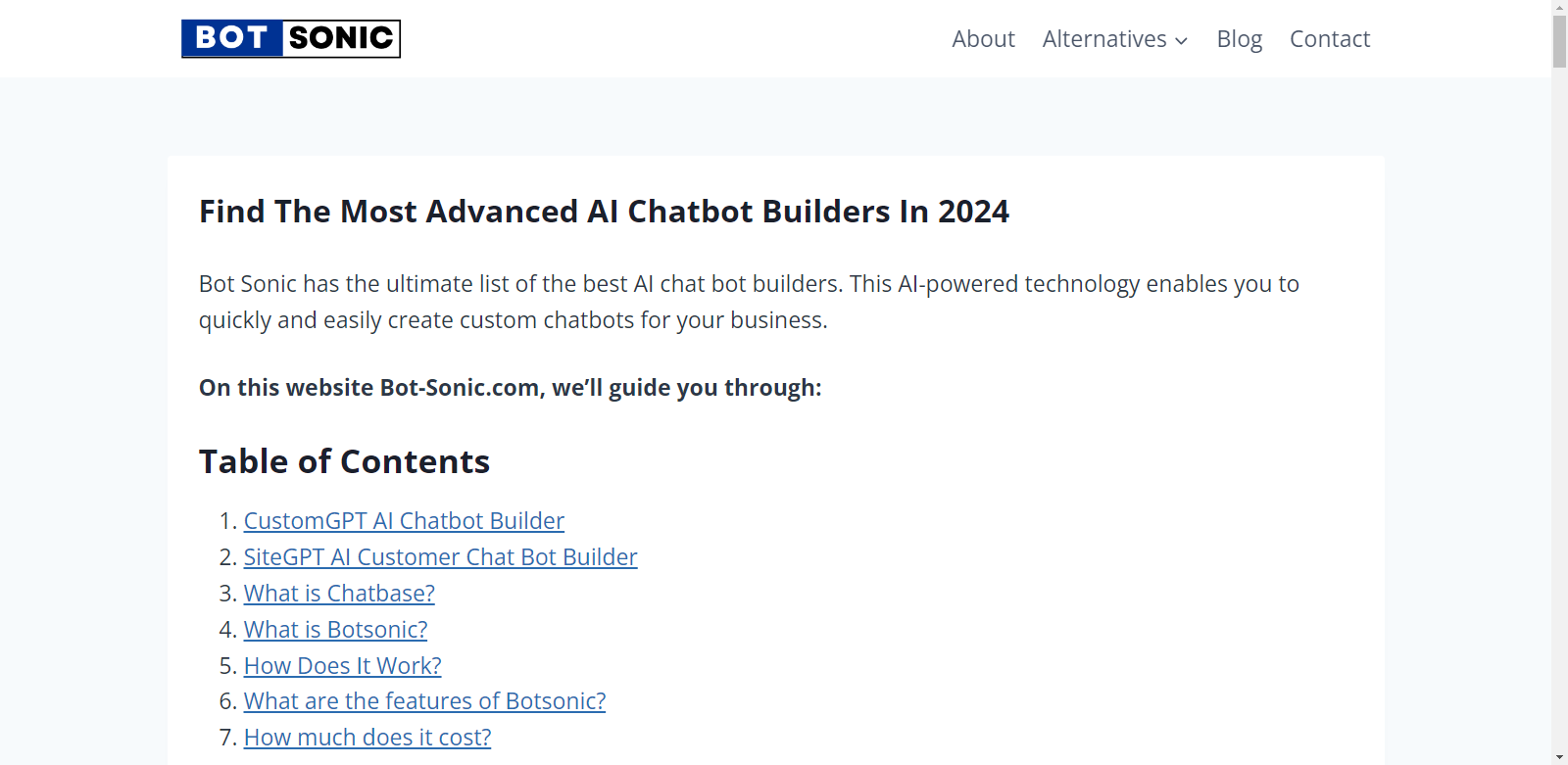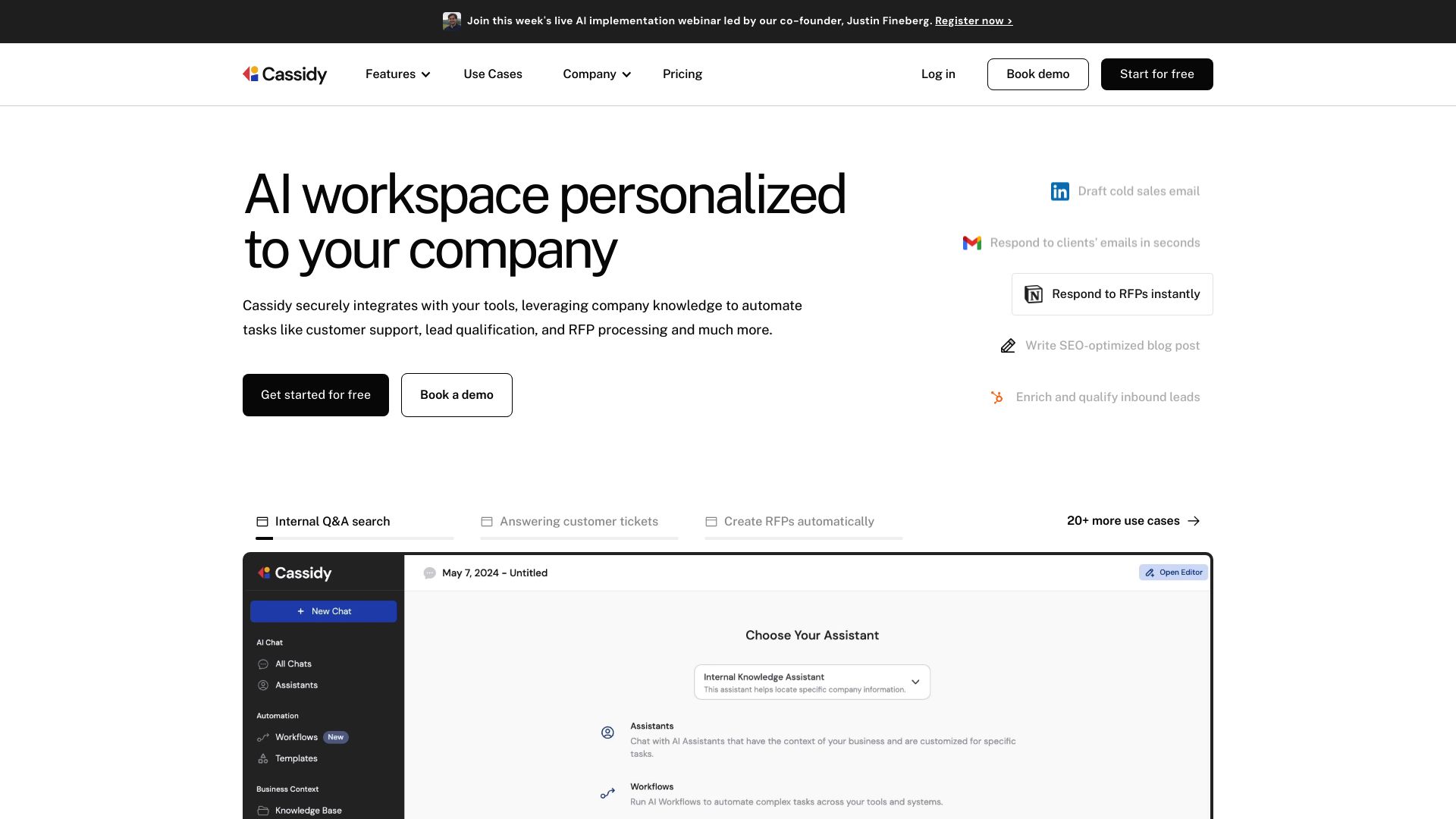Botsonic/Writesonic vs. Cassidy: AI Chatbot Showdown
AI-powered chatbots and automation tools revolutionize how businesses interact with customers and streamline operations. This comparison explores Botsonic/Writesonic vs. Cassidy, and SmythOS — three leading platforms in the AI agent space. We’ll examine their key features, strengths, and limitations to help you choose the right solution for your organization’s needs.
Whether you’re a developer seeking advanced customization, a business leader focused on scalability, or a non-technical user looking for accessible AI tools, this analysis provides insights to guide your decision-making process. Discover how these platforms leverage cutting-edge AI to enhance customer experiences, boost productivity, and drive innovation across industries.
Botsonic/Writesonic Overview
Botsonic/Writesonic empowers businesses to create intelligent chatbots without coding expertise. This AI-powered platform leverages GPT-4 technology to deliver personalized customer interactions across various industries.


Botsonic’s no-code visual builder enables rapid chatbot development and customization. Users can train their bots on specific data sources, including websites, documents, and YouTube transcripts. This ensures chatbots provide contextually relevant responses aligned with brand identity and customer needs.
Botsonic’s no-code visual builder enables rapid chatbot development and customization. Users can train their bots on specific data sources… This ensures chatbots provide contextually relevant responses…
The platform excels in multilingual support, offering conversations in over ten languages. This global reach expands customer engagement possibilities for businesses. Botsonic also integrates seamlessly with popular tools like Salesforce, Google Docs, and messaging platforms, streamlining workflow integration.
While Botsonic offers robust features for chatbot creation and deployment, it lacks some advanced capabilities. The platform doesn’t support multimodal inputs or provide a dedicated debug mode for real-time troubleshooting. Additionally, there’s no explicit support for multi-agent collaboration or scheduled agent deployments.
Botsonic positions itself as a comprehensive solution for businesses seeking to enhance customer interactions through AI. Its user-friendly interface and powerful customization options make it accessible to both technical and non-technical users. However, organizations with highly specialized AI requirements may find some limitations in its current feature set.
Cassidy Overview
Cassidy specializes in creating customized AI automations and assistants tailored to specific business needs. The platform securely integrates with existing tools and leverages company knowledge to automate tasks like customer support, lead qualification, and RFP processing. This personalization enhances productivity by equipping AI assistants and workflows with full context specific to each business.
Cassidy specializes in creating customized AI automations and assistants tailored to specific business needs. The platform securely integrates with existing tools and leverages company knowledge to automate tasks…


Cassidy’s platform offers a model-agnostic approach, allowing users to employ any foundational AI model. This flexibility ensures future-proofing of AI strategies. The platform seamlessly integrates with various data sources, including Google Drive, Slack, and Notion, expanding its utility across different business tools. Cassidy prioritizes enterprise-grade security, ensuring data confidentiality by never using client data for model training.
A standout feature of Cassidy is its user-friendly workflow builder. The no-code, drag-and-drop interface enables users to construct complex AI automations without programming skills. This accessibility democratizes AI technology, allowing non-technical users to harness its power for enhancing productivity and operational efficiency.
A standout feature of Cassidy is its user-friendly workflow builder. The no-code, drag-and-drop interface enables users to construct complex AI automations without programming skills.
Cassidy’s vision centers on improving AI adoption in businesses by making it accessible and useful for non-technical users. The platform aims to empower all employees, regardless of technical background, to leverage AI for productivity enhancement. However, the platform’s broad focus on accessibility might limit its appeal to highly technical users seeking more advanced customization options. Additionally, while Cassidy offers extensive integration capabilities, it may not provide the same level of specialized features found in more niche-focused AI platforms.
Feature Comparison
SmythOS and Botsonic/Writesonic offer robust AI agent building capabilities, but differ significantly in key areas. SmythOS provides a comprehensive hosted vector database, enabling efficient management and retrieval of large-scale data. This feature is absent in Botsonic/Writesonic, limiting its ability to handle extensive datasets. SmythOS also excels in multi-agent collaboration, allowing multiple AI agents to work together on complex tasks. Botsonic/Writesonic lacks this capability, potentially constraining its effectiveness in scenarios requiring coordinated AI efforts.
In terms of security, SmythOS implements constrained alignment, ensuring AI behaviors align with organizational goals and ethical guidelines. Botsonic/Writesonic does not explicitly offer this feature, which may raise concerns for businesses prioritizing controlled AI operations. Additionally, SmythOS’s debug mode provides real-time troubleshooting for developers, a tool not mentioned in Botsonic/Writesonic’s feature set. This omission could impact the efficiency of AI development and refinement processes for Botsonic/Writesonic users.
While both platforms offer strong integration capabilities, SmythOS’s support for Hugging Face AI models and Zapier APIs extends its versatility. Botsonic/Writesonic’s integration options, while substantial, do not explicitly include these specific tools, potentially limiting its adaptability in certain AI development scenarios. These distinctions highlight SmythOS’s broader scope and more advanced features in AI agent development and deployment.
Feature Comparison Table
| Botsonic/Writesonic | Cassidy | SmythOS | |
|---|---|---|---|
| CORE FEATURES | |||
| Visual Builder | ❌ | ✅ | ✅ |
| Autonomous Agents | ✅ | ❌ | ✅ |
| Explainability & Transparency | ✅ | ❌ | ✅ |
| Debug Tools | ❌ | ✅ | ✅ |
| Multimodal | ❌ | ❌ | ✅ |
| Multi-Agent Collaboration | ❌ | ❌ | ✅ |
| Audit Logs for Analytics | ✅ | ❌ | ✅ |
| Work as Team | ❌ | ✅ | ✅ |
| Bulk Work | ❌ | ✅ | ✅ |
| Agent Work Scheduler | ❌ | ✅ | ✅ |
| SECURITY | |||
| Constrained Alignment | ❌ | ✅ | ✅ |
| Data Encryption | ❌ | ✅ | ✅ |
| OAuth | ❌ | ✅ | ✅ |
| IP Control | ✅ | ❌ | ✅ |
| COMPONENTS | |||
| Huggingface AIs | ❌ | ❌ | ✅ |
| Zapier APIs | ❌ | ✅ | ✅ |
| Classifiers | ❌ | ❌ | ✅ |
| Data Lakes | ❌ | ❌ | ✅ |
| DEPLOYMENT OPTIONS (EMBODIMENTS) | |||
| Deploy as Webhook | ❌ | ✅ | ✅ |
| Staging Domains | ❌ | ❌ | ✅ |
| Production Domains | ✅ | ❌ | ✅ |
| API Authentication (OAuth + Key) | ❌ | ❌ | ✅ |
| Deploy as Site Chat | ✅ | ❌ | ✅ |
| Deploy as Scheduled Agent | ❌ | ✅ | ✅ |
| Deploy as GPT | ✅ | ❌ | ✅ |
| DATA LAKE SUPPORT | |||
| Hosted Vector Database | ❌ | ❌ | ✅ |
| Sitemap Crawler | ✅ | ❌ | ✅ |
| YouTube Transcript Crawler | ✅ | ❌ | ✅ |
| URL Crawler | ✅ | ❌ | ✅ |
Best Alternative to Botsonic/Writesonic and Cassidy
SmythOS stands out as the superior alternative to Botsonic/Writesonic and Cassidy, offering a comprehensive AI automation platform that surpasses both in capabilities and ease of use. Our platform combines powerful features with intuitive design, making advanced AI accessible to users of all skill levels.
We’ve engineered SmythOS to address the limitations found in Botsonic/Writesonic and Cassidy. While these competitors offer some AI functionalities, they fall short in critical areas. SmythOS excels with its robust hosted vector database, enabling efficient management of large-scale data—a feature notably absent in both Botsonic/Writesonic and Cassidy. This capability allows users to handle extensive datasets with ease, enhancing the overall performance and utility of AI agents.
SmythOS excels with its robust hosted vector database, enabling efficient management of large-scale data—a feature notably absent in both Botsonic/Writesonic and Cassidy.
Multi-agent collaboration sets SmythOS apart from both Botsonic/Writesonic and Cassidy. Our platform enables multiple AI agents to work together seamlessly on complex tasks, a feature that neither competitor offers. This collaborative approach significantly expands the scope and efficiency of AI-driven projects, allowing users to tackle more sophisticated challenges.
Multi-agent collaboration sets SmythOS apart from both Botsonic/Writesonic and Cassidy… allowing users to tackle more sophisticated challenges.
Security is paramount in AI development, and SmythOS leads the pack with its implementation of constrained alignment. This feature ensures AI behaviors adhere to organizational goals and ethical guidelines—a critical consideration that Botsonic/Writesonic and Cassidy overlook. We also provide a comprehensive debug mode, offering real-time troubleshooting capabilities that streamline the development process, a tool not explicitly mentioned in either competitor’s feature set.
SmythOS’s versatility shines through its extensive integration options, including support for Hugging Face AI models and Zapier APIs. This broad compatibility allows users to leverage a wide array of tools and services, creating a more flexible and powerful AI ecosystem. While Botsonic/Writesonic and Cassidy offer some integrations, they don’t match the breadth and depth of options available with SmythOS. Our platform’s ability to adapt to various development scenarios and integrate seamlessly with existing workflows makes it the ideal choice for businesses and developers looking to harness the full potential of AI technology.
Conclusion
Botsonic/Writesonic and Cassidy offer unique strengths in the AI chatbot and automation space. Botsonic/Writesonic excels in rapid chatbot development with its no-code visual builder and multilingual support, making it accessible for businesses seeking to enhance customer interactions. Cassidy stands out with its customizable AI automations and user-friendly workflow builder, empowering non-technical users to leverage AI for productivity gains.
However, SmythOS emerges as the superior choice, offering a comprehensive suite of advanced features that outpace both alternatives. Our platform’s hosted vector database enables efficient management of large-scale data, a capability absent in Botsonic/Writesonic. SmythOS’s multi-agent collaboration feature surpasses Cassidy’s offerings, allowing for more complex and coordinated AI efforts.
Unlike its competitors, SmythOS implements constrained alignment, ensuring AI behaviors align with organizational goals and ethical guidelines. Our debug mode provides real-time troubleshooting, a critical tool for efficient AI development not explicitly offered by Botsonic/Writesonic or Cassidy. Additionally, SmythOS’s support for Hugging Face AI models and Zapier APIs extends its versatility beyond what the alternatives provide.
We invite you to explore our diverse range of AI-powered agent templates and experience the unmatched capabilities of SmythOS. Create a free SmythOS account today and join the AI revolution, or dive into our comprehensive documentation to discover how SmythOS can transform your AI initiatives.
Last updated:
Disclaimer: The information presented in this article is for general informational purposes only and is provided as is. While we strive to keep the content up-to-date and accurate, we make no representations or warranties of any kind, express or implied, about the completeness, accuracy, reliability, suitability, or availability of the information contained in this article.
Any reliance you place on such information is strictly at your own risk. We reserve the right to make additions, deletions, or modifications to the contents of this article at any time without prior notice.
In no event will we be liable for any loss or damage including without limitation, indirect or consequential loss or damage, or any loss or damage whatsoever arising from loss of data, profits, or any other loss not specified herein arising out of, or in connection with, the use of this article.
Despite our best efforts, this article may contain oversights, errors, or omissions. If you notice any inaccuracies or have concerns about the content, please report them through our content feedback form. Your input helps us maintain the quality and reliability of our information.
